Risk Zoning of Permafrost Thaw Settlement in the Qinghai–Tibet Engineering Corridor
Abstract
:1. Introduction
2. Materials and Methods
2.1. Data Source
2.2. Prediction Model of Permafrost Thaw Settlement
2.2.1. Determination of the Thaw Settlement Coefficient (A)
2.2.2. Prediction Model of Permafrost Thaw Depth (∆h)
2.3. Risk Classification of Thaw Settlement
3. Results
3.1. Distribution of Thaw Depth
3.2. Risk Characteristics of Thaw Settlement
3.3. Influence Analysis of Ice Content
4. Discussion
4.1. Error Analysis of RBF Neural Network Models
4.2. Analysis of Influencing Factors of Thaw Settlement
5. Conclusions
- (1)
- Large thaw depth areas were widely distributed in the Qinghai–Tibet engineering corridor, among which thaw depths of more than 9 m were mainly distributed in the Gaerqu River Basin and Riachiqu River Basin, and thaw depths of 6–9 m were mainly distributed in the Beiluhe River Basin, Riachiqu River Basin and Buqu River Basin regions.
- (2)
- Thaw settlement risk was divided into four risk levels, namely significant risk (I ≥ 0.5), high risk (0.25 ≤ I < 0.5), medium risk (0.1 ≤ I < 0.25) and low risk (I < 0.1) levels, with the areas of these four risk levels covering 3868.67 km2, 1594.21 km2, 2456.10 km2 and 558.78 km2, respectively. The main thaw settlement risk in the Qinghai–Tibet engineering corridor was the significant risk level, which was distributed across the Chumar River Basin, Beiluhe River Basin, Gaerqu River Basin and Tanggula Mountain regions.
- (3)
- Ice content was found to be the most significant influence factor of regional thaw settlement, while the elevation, surface temperature, vegetation index and latitude factors also had an impact on the thaw settlement, although their specific relationships with thaw settlement need to be further studied.
Author Contributions
Funding
Data Availability Statement
Acknowledgments
Conflicts of Interest
References
- Zhao, L.; Wu, T.H.; Xie, C.W.; Li, R.; Wu, X.D.; Yao, J.M.; Yue, G.Y.; Xiao, Y. Permafrost survey and monitoring provide scientific support for geoscience research, environmental protection and engineering construction in the Qinghai Tibet Plateau. J. Chin. Acad. Sci. 2017, 32, 1159–1168. [Google Scholar] [CrossRef]
- Akhtar, S.; Hollaender, H.; Yuan, Q.Y. Impact of heat and contaminants transfer from landfills to permafrost subgrade in arctic climate: A review. Cold Reg. Sci. Technol. 2023, 206, 103737. [Google Scholar] [CrossRef]
- Varlamov, S.P. Thermal monitoring of railway subgrade in a region of ice-rich permafrost, Yakutia, Russia. Cold Reg. Sci. Technol. 2018, 155, 184–192. [Google Scholar] [CrossRef]
- Ahmed, A.; Islam, M.A. Effect of using geosynthetics in mitigation of freeze-thaw through numerical analysis. In Proceedings of the 4th Session on Geotechnical Earthquake Engineering and Special Topics at Geo-Congress on Vision, Insight, Outlook, Minneapolis, MN, USA, 25–28 February 2020. [Google Scholar] [CrossRef]
- Antonovskaya, G.N.; Orlova, I.P.; Kapustian, N.K. Ultralow-frequency seismic sounding of railway subgrade state by passing trains. Can. Geotech. J. 2022, 59, 2151–2162. [Google Scholar] [CrossRef]
- Bommer, C.; Fitze, P.; Schneider, H. Thaw-Consolidation Effects on the Stability of Alpine Talus Slopes in Permafrost. Permafr. Periglac. Process. 2012, 23, 267–276. [Google Scholar] [CrossRef]
- Patton, A.I.; Rathburn, S.L.; Capps, D.M. Ongoing Landslide Deformation in Thawing Permafrost. Geophys. Res. Lett. 2021, 48, 16. [Google Scholar] [CrossRef]
- Weinstein, Y.; Rotem, D.; Kooi, H. Radium isotope fingerprinting of permafrost—Applications to thawing and intra-permafrost processes. Permafr. Periglac. Process. 2019, 30, 104–112. [Google Scholar] [CrossRef]
- Erik, R.; Pullman, M.; Torre, J.; Yuri, S. Thaw settlement in soils of the arctic coastal plain, alaska. Arct. Antarct. Alp. Res. 2007, 39, 468–476. [Google Scholar]
- Song, Y.; Jin, L.; Wang, H.B. Vegetation Changes along the Qinghai-Tibet Plateau Engineering Corridor Since 2000 Induced by Climate Change and Human Activities. Remote Sens. 2018, 10, 95. [Google Scholar] [CrossRef] [Green Version]
- Pandey, A.C.; Ghosh, T.; Parida, B.R. Modeling Permafrost Distribution Using Geoinformatics in the Alaknanda Valley, Uttarakhand, India. Sustainability 2022, 14, 15731. [Google Scholar] [CrossRef]
- Osokin, A.B. Permafrost Temperature Dynamics in Subgrade and Foundation Reliability Enhancement. Soil Mech. Found. Eng. 2015, 52, 282–285. [Google Scholar] [CrossRef]
- Dashjamts, D.; Altantsetseg, J. Research on consolidation of frozen soils upon thawing. In Proceedings of the 2011 6th International Forum on Strategic Technology, Harbin, China, 22–24 August 2011. [Google Scholar] [CrossRef]
- Ma, W.; Wen, Z.; Sheng, Y.; Wu, Q.B.; Wang, D.Y.; Feng, W.J. Remedying embankment thaw settlement in a warm permafrost region with thermosyphons and crushed rock revetment. Can. Geotech. J. 2012, 49, 1005–1014. [Google Scholar] [CrossRef]
- Sun, Z.Z.; Ma, W.; Zhang, S.J.; Mu, Y.H.; Yun, H.B.; Wang, H.L. Characteristics of thawed interlayer and its effect on embankment settlement along the Qinghai-Tibet Railway in permafrost regions. J. Mt. Sci. 2018, 15, 1090–1100. [Google Scholar] [CrossRef]
- Yu, G.M.; Ge, R.X.; Zeng, X.K.; Yu, Y.N.; Zhang, Z.; Meng, X.G.; Qin, Y.J. Particularity and prediction method of ground settlement caused by subway tunnel construction in permafrost area. Transp. Soil Eng. Cold Reg. 2020, 49, 531–539. [Google Scholar] [CrossRef]
- Wang, D.R.; Tighe, S.L.; Yin, S.D. Preliminary analysis of permafrost degradation in Ingraham Trail, Northwest Territories. In Proceedings of the Canadian Society of Civil Engineering Annual Conference, Singapore, 18 May 2022. [Google Scholar] [CrossRef]
- Hjort, J.; Streletskiy, D.; Dore, G. Impacts of permafrost degradation on infra-structure. Nat. Rev. Earth Environ. 2022, 3, 24–38. [Google Scholar] [CrossRef]
- Niu, F.J.; Ma, W.; Wu, Q.B. Thermal stability and freezing-thawing hazards of main permafrost roadbed projects on Qinghai-Tibet Railway. J. Earth Sci. Environ. 2011, 33, 196–206. [Google Scholar]
- Ruan, G.F.; Zhang, J.M.; Chai, M.T. Research on Risk zoning of melt-sink disaster in Qinghai-Tibet Engineering Corridor under climate change. J. Glaciol. Geocryol. 2014, 36, 811–817. [Google Scholar]
- Hong, E.; Perkins, R.; Trainor, S. Thaw Settlement Hazard of Permafrost Related to Climate Warming in Alaska. Arctic 2014, 67, 93–103. [Google Scholar] [CrossRef] [Green Version]
- Zaretskii, Y.K. Scientific legacy of NA Tsytovich. Soil Mech. Found. Eng. 2000, 37, 131–139. [Google Scholar] [CrossRef]
- Tang, L.Y.; Yang, L.J.; Wang, X.G.; Yang, G.S.; Ren, X.; Li, Z.; Li, G.Y. Numerical analysis of frost heave and thawing settlement of the pile–soil system in degraded permafrost region. Environ. Earth Sci. 2021, 80, 693. [Google Scholar] [CrossRef]
- Liu, X.L.; Chen, Y.X.; Meng, Q.L.; Song, J.B.; Zhang, X.M. Thaw settlement of runways in permafrost regions under aircraft load. Eur. J. Environ. Civ. Eng. 2022, 27, 500–518. [Google Scholar] [CrossRef]
- Ni, J.; Wu, T.; Zhu, X.; Wu, X.; Pang, Q.; Zou, D.; Chen, J.; Li, R.; Hu, G.; Du, Y.; et al. Risk assessment of potential thaw settlement hazard in the permafrost regions of Qinghai-Tibet Plateau. Sci. Total Environ. 2021, 776, 145855. [Google Scholar] [CrossRef]
- Sun, Z.; Zhao, L.; Hu, G.; Zhou, H.; Liu, S.; Qiao, Y.; Du, E.; Zou, D.; Xie, C. Numerical Simulation of Thaw Settlement and Permafrost Changes at Three Sites Along the Qinghai-Tibet Engineering Corridor in a Warming Climate. Geophys. Res. Lett. 2022, 49, 10. [Google Scholar] [CrossRef]
- Yang, B.; Liu, H.X.; Kang, E.L. Spatio-temporal Cokriging method for assimilating and downscaling multi-scale remote sensing data. Remote Sens. Environ. 2021, 255, 112190. [Google Scholar] [CrossRef]
- Hassan, W.; Raza, M.F.; Alshameri, B. Statistical interpolation and spatial mapping of geotechnical soil parameters of District Sargodha, Pakistan. Bull. Eng. Geol. Environ. 2023, 82, 37. [Google Scholar] [CrossRef]
- Zhang, J.M. Research on the Stability of Frozen Soil Roadbeds in the Qinghai Tibet Plateau and the Classification of Permafrost in Highway Engineering. Ph.D. Thesis, Institute of Environment and Engineering in Cold and Dry Regions, Chinese Academy of Sciences, Beijing, China, 2004. [Google Scholar]
- Cui, F.Q.; Chen, J.B.; Liu, Z.Y.; Zhu, W.; Wang, W.; Zhang, W. Prediction Model of Thermal Thawing Sensibility and Thaw Depth for Permafrost Embankment along the Qinghai-Tibet Engineering Corridor Using MODIS Data. J. Sens. 2020, 2020, 8819476. [Google Scholar] [CrossRef]
- Luo, J.; Lin, Z.J.; Yin, G.A.; Niu, F.J.; Liu, M.H.; Gao, Z.Y.; Fan, X.W. The ground thermal regime and permafrost warming at two upland, sloping, and undisturbed sites, Kunlun Mountain, Qinghai-Tibet Plateau. Cold Reg. Sci. Technol. 2019, 167, 102862. [Google Scholar] [CrossRef]
- Way, R.G.; Lewkowicz, A.G. Environmental controls on ground temperature and permafrost in Labrador, northeast Canada. Permafr. Periglac. Process. 2018, 29, 73–85. [Google Scholar] [CrossRef]
- Zorigt, M.; Kwadijk, J.; Van-Beek, E.; Kenner, S. Estimating thawing depths and mean annual ground temperatures in the Khuvsgul region of Mongolia. Environ. Earth Sci. 2016, 75, 10. [Google Scholar] [CrossRef]
- Yang, K. Variation and numerical simulation of temperature field in permafrost subgrade. China Sci. Technol. Inf. 2022, 14, 81–83. [Google Scholar] [CrossRef]
- Chaves, D.A.; Lyra, G.B.; Francelino, M.R.; Silva, L.D.B.; Thomazini, A.; Schaefer, C.E.G.R. Active layer and permafrost thermal regime in a patterned ground soil in Maritime Antarctica, and relationship with climate variability models. Sci. Total Environ. 2017, 584, 572–585. [Google Scholar] [CrossRef]
- Baral, P.; Haq, M.A. Spatial prediction of permafrost occurrence in Sikkim Himalayas using logistic regression, random forests, support vector machines and neural networks. Geomorphology 2020, 371, 107331. [Google Scholar] [CrossRef]
- Deluigi, N.; Lambiel, C.; Kanevski, M. Data-driven mapping of the potential mountain permafrost distribution. Sci. Total Environ. 2017, 590, 370–380. [Google Scholar] [CrossRef] [PubMed] [Green Version]
- Aalto, J.; Karjalainen, O.; Hjort, J.; Luoto, M. Statistical Forecasting of Current and Future Circum-Arctic Ground Temperatures and Active Layer Thickness. Geophys. Res. Lett. 2018, 45, 4889–4898. [Google Scholar] [CrossRef] [Green Version]
- Ni, J.; Wu, T.; Zhu, X.; Hu, G.; Zou, D.; Wu, X.; Li, R.; Xie, C.; Qiao, Y.; Pang, Q.; et al. Simulation of the Present and Future Projection of Permafrost on the Qinghai-Tibet Plateau with Statistical and Machine Learning Models. J. Geophys. Res.-Atmos. 2021, 126, 2. [Google Scholar] [CrossRef]
- Wang, L. Principle, classification and application of artificial neural network. J. Inf. Sci. Technol. 2014, 360, 240–241. [Google Scholar] [CrossRef]
- Pang, Q.Q.; Li, S.X.; Wu, T.H.; Zhang, W.G. Simulation of active layer thickness distribution in permafrost area of Qinghai-Tibet Plateau. J. Glaciol. Geocryol. 2006, 28, 390–395. [Google Scholar]
- Bang-Andreasen, T.; Schostag, M.; Prieme, A.; Elberling, B.; Jacobsen, C.S. Potential microbial contamination during sampling of permafrost soil assessed by tracers. Sci. Rep. 2017, 7, 43338. [Google Scholar] [CrossRef]
- Morgalev, Y.N.; Lushchaeva, I.V.; Morgaleva, T.G.; Kolesnichenko, L.G.; Loiko, S.V.; Krickov, I.V.; Lim, A.; Raudina, T.V. Bacteria primarily metabolize at the active layer/permafrost border in the peat core from a permafrost region in western Siberia. Polar Biol. 2017, 40, 1645–1659. [Google Scholar] [CrossRef]
- Liu, Z.Y.; Huang, C.; Yu, H.; Zhong, Z.T.; Cui, F.Q. Prediction model and distribution characteristics of active layer thickness in Qinghai-Tibet Engineering Corridor. J. Glaciol. Geocryol. 2021, 43, 1458–1467. [Google Scholar] [CrossRef]
- Peng, H.; Ma, W.; Mu, Y.H. Qinghai-Tibet highway ordinary fill subgrade deformation characteristics and the roadbed disease investigation analysis. Rock Soil Mech. 2015, 4, 2049–2056. [Google Scholar] [CrossRef]
- Wu, Y.H. The first phase of Publicity and Implementation Meeting of Design Code for Highway Subgrade JTG D30—2015 was successfully held in Guangzhou. Eng. Constr. Stand. 2015, 198, 70. [Google Scholar] [CrossRef]
- Ku, X.B.; Dong, X.F.; Wu, Q.B. Analysis of engineering complexity in permafrost regions of Qinghai—Tibet railway. J. Eng. Geol. 2007, 62, 739–745. [Google Scholar] [CrossRef]
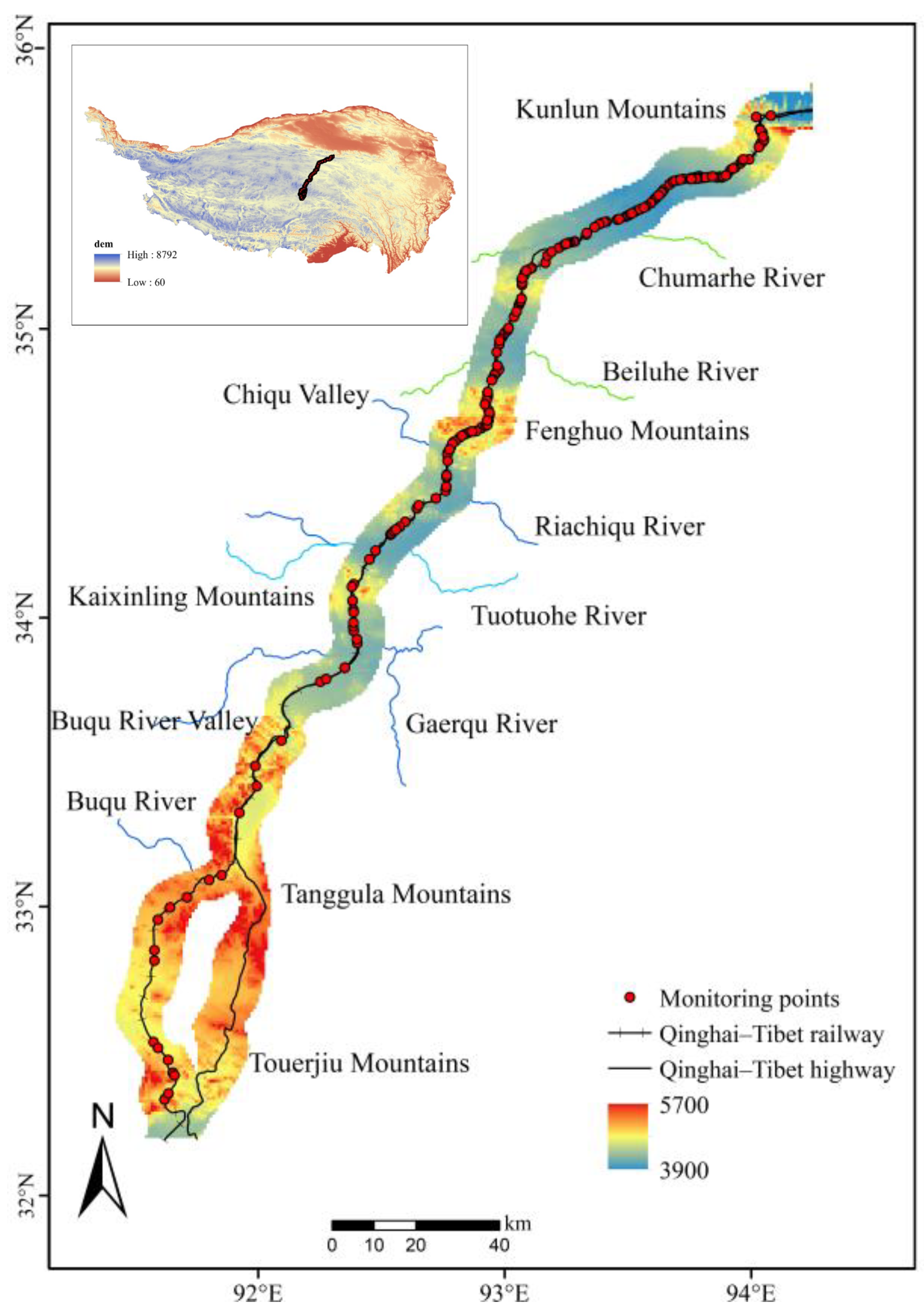
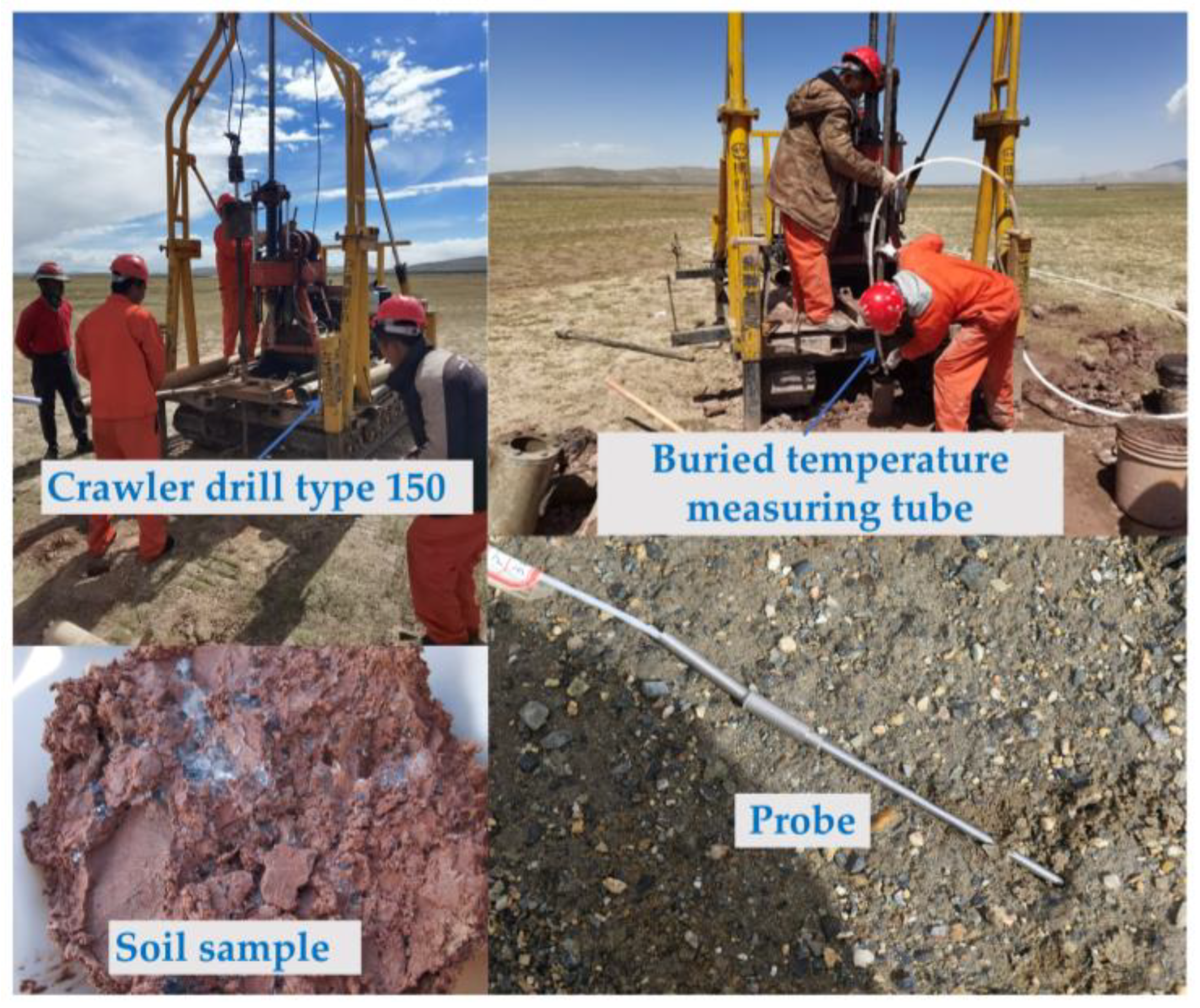


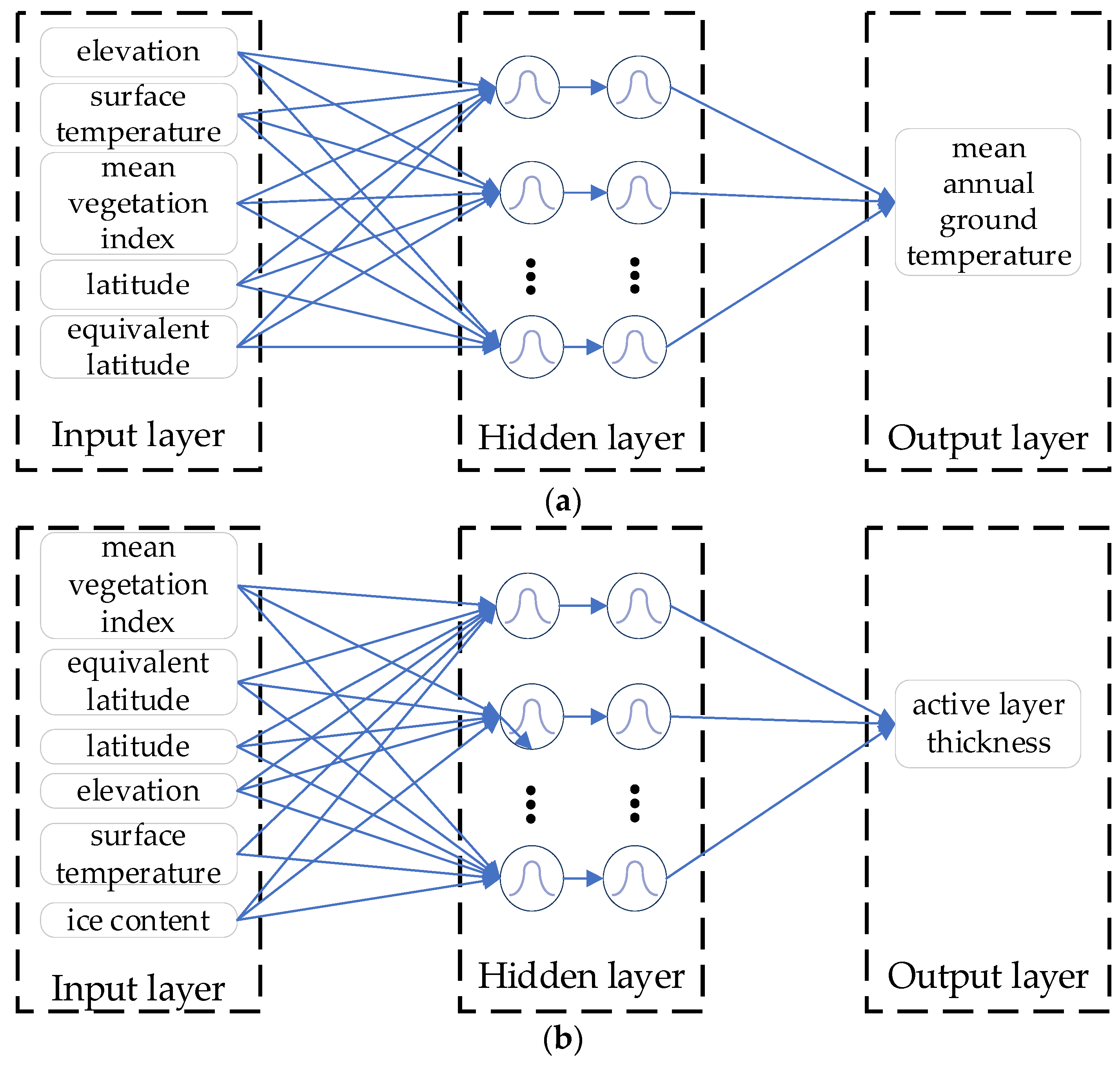


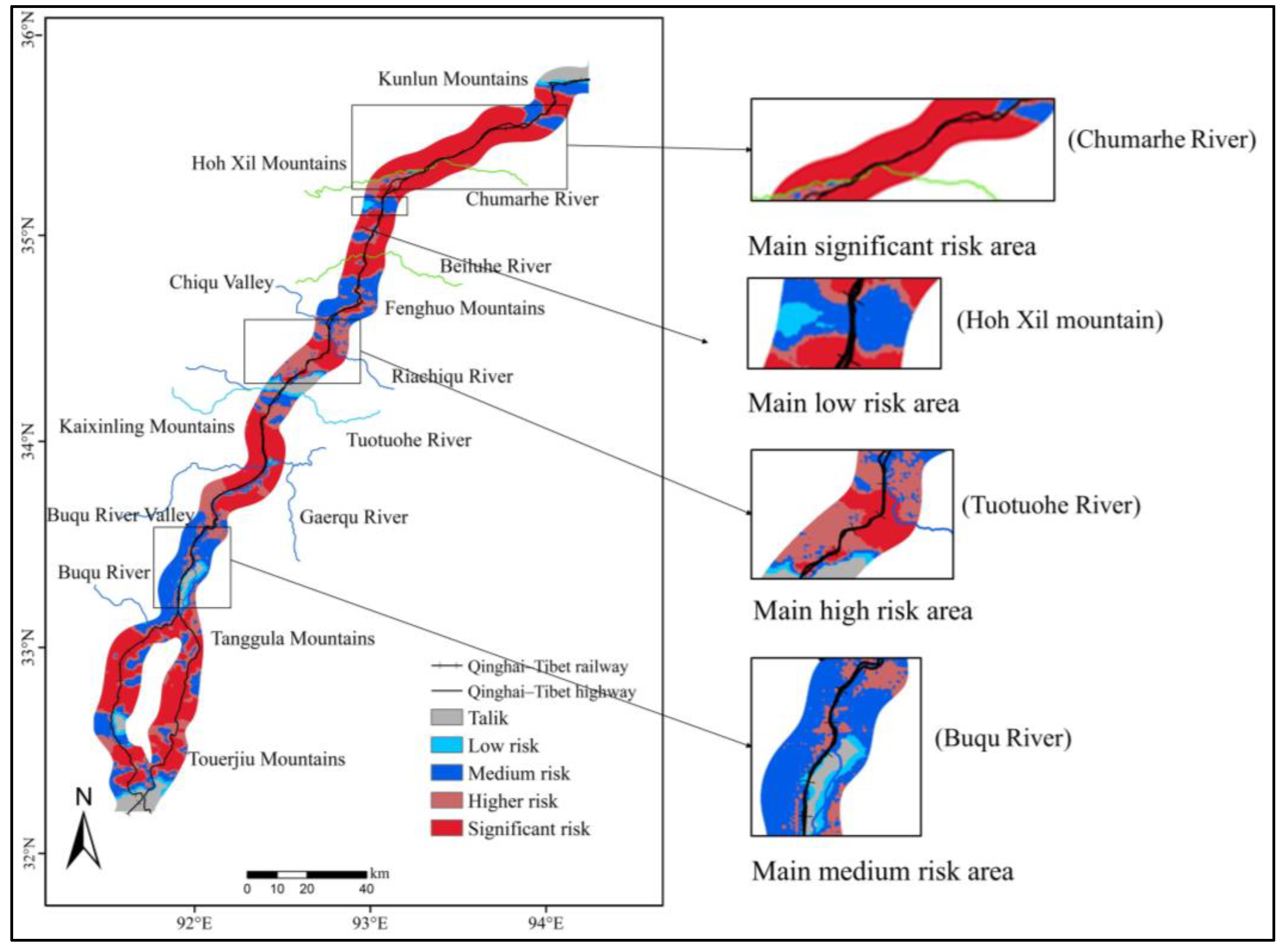
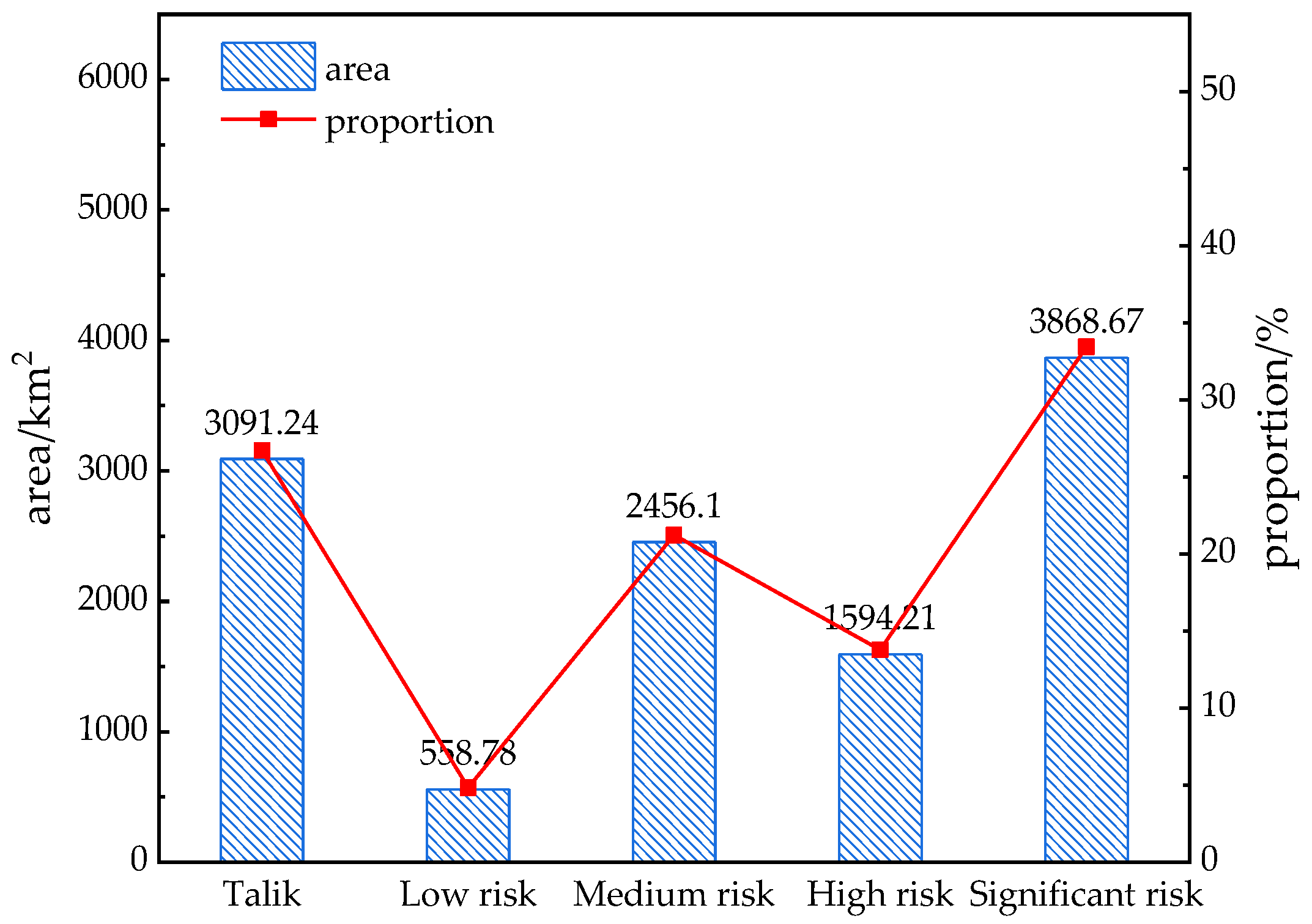
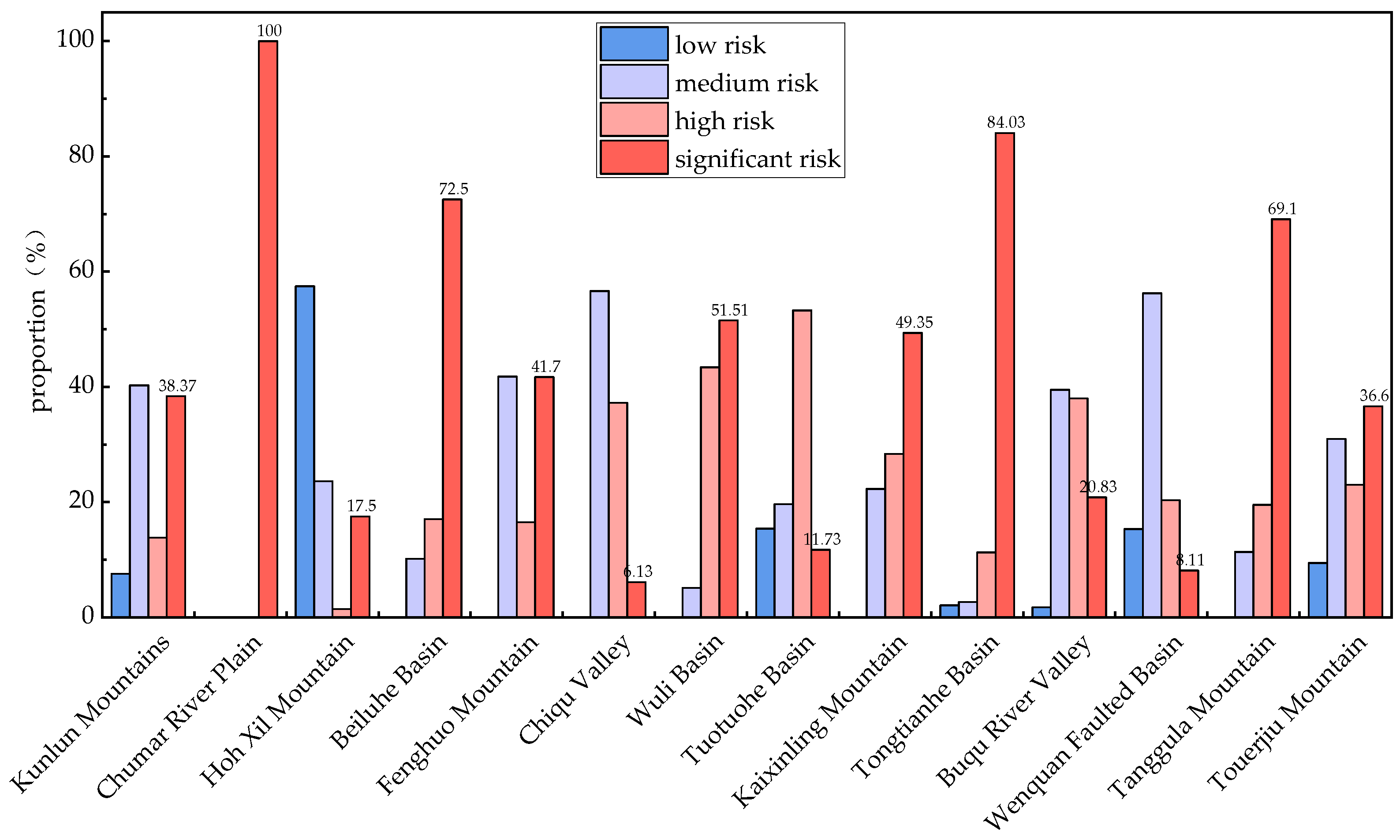

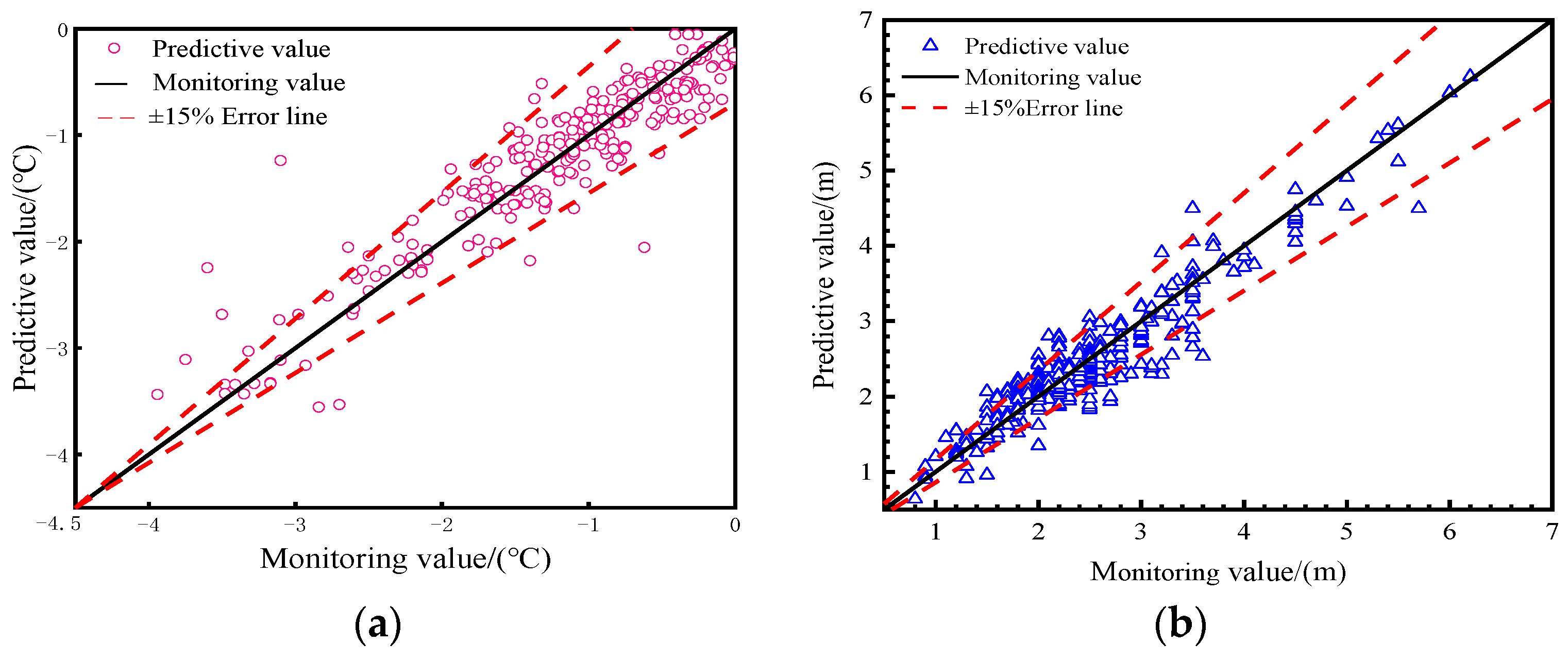

| Data | Source | Resolution |
|---|---|---|
| Elevation | SRTM DEM | 90 × 90 m |
| Surface temperature | MOD11A2 (2000~2016) | 1000 × 1000 m |
| Vegetation index (NDVI) | MOD13Q1 (2000~2016) | 250 × 250 m |
| Ice Content | Ice-Poor | Icy Soil | Ice-Rich | Ice-Saturated | Ice Layer with Soil Inclusions |
|---|---|---|---|---|---|
| Thaw settlement coefficient | 0.01 | 0.03 | 0.065 | 0.175 | 0.25 |
| Thaw Settlement/m | I < 0.1 | 0.1 ≤ I < 0.25 | 0.25 ≤ I < 0.5 | I ≥ 0.5 |
|---|---|---|---|---|
| Risk classification | Low risk | Medium risk | High risk | Significant risk |
| Evaluating Indicator | Mean Annual Ground Temperatures | Active-Layer Thicknesses |
|---|---|---|
| R2 | 0.81 | 0.84 |
| MAE | 0.27 | 0.11 |
| RMSE | 0.37 | 0.33 |
| Impact Factor | Ice Content | Elevation | Equivalent Latitude | Surface Temperature | Vegetation Index | Latitude |
|---|---|---|---|---|---|---|
| Kunlun Mountains | 0.120 | 0.097 | −0.300 | 0.072 | 0.037 | −0.438 ** |
| Chumar River Plain | 0.258 ** | −0.664 ** | 0.020 | 0.464 ** | 0.314 ** | −0.313 ** |
| Hoh Xil Mountains | 0.582 ** | −0.441 ** | −0.116 ** | 0.328 ** | −0.410 ** | 0.209 ** |
| Beiluhe Basin | 0.859 | −0.147 ** | −0.012 | 0.234 ** | −0.406 ** | −0.157 ** |
| Fenghuo Mountains | 0.889 ** | −0.569 ** | −0.072 | 0.577 ** | −0.372 ** | 0.583 ** |
| Chiqu Valley | 0.544 ** | −0.189 ** | 0.022 | 0.174 ** | −0.035 | −0.024 |
| Wuli Basin | 0.250 ** | −0.259 ** | 0.040 | −0.087 | 0.035 | −0.160 * |
| Tuotuohe Basin | 0.067 | −0.487 ** | 0.100 | 0.156 * | −0.388 ** | −0.026 |
| Kaixinling Mountains | 0.160 ** | −0.043 | −0.159 ** | 0.061 | −0.096 | −0.739 ** |
| Tongtianhe Basin | 0.074 | −0.179 ** | −0.135 ** | −0.110 ** | 0.230 ** | 0.670 ** |
| Buqu River Valley | 0.194 ** | −0.548 ** | 0.072 * | 0.490 ** | −0.044 | 0.429 ** |
| Wenquan Faulted Basin | −0.026 | −0.293 ** | 0.032 | 0.176 ** | 0.300 ** | −0.257 ** |
| Tanggula Mountains | 0.054 * | −0.425 ** | −0.119 ** | 0.345 ** | 0.137 ** | −0.267 ** |
| Touerjiu Mountains | 0.049 | −0.192 ** | −0.028 | 0.104 ** | 0.258 ** | −0.080 * |
| Region | Mean Annual Ground Temperatures | Active-Layer Thicknesses | ||
|---|---|---|---|---|
| F | Sig | F | Sig | |
| Kunlun Mountains | 1.566 | 0.281 | 1.306 | 0.383 |
| Chumar River Plain | 7.497 | 0 | 1.478 | 0.055 |
| Hoh Xil Mountains | 2.654 | 0 | 3.418 | 0 |
| Beiluhe Basin | 1.429 | 0.143 | 1.531 | 0.034 |
| Fenghuo Mountains | 2.450 | 0.031 | 1.323 | 0.065 |
| Chiqu Valley | 1.531 | 0.022 | 1.830 | 0 |
| Wuli Basin | 1.312 | 0.212 | 2.470 | 0.001 |
| Tuotuohe Basin | 5.885 | 0 | 7.846 | 0 |
| Kaixinling Mountains | 1.579 | 0.001 | 1.795 | 0 |
| Tongtianhe Basin | 6.594 | 0 | 5.145 | 0.116 |
| Buqu River Valley | 1.304 | 0.035 | 2.421 | 0.002 |
| Wenquan Faulted Basin | 8.307 | 0 | 11.073 | 0 |
| Tanggula Mountains | 1.385 | 0.684 | 8.607 | 0 |
| Touerjiu Mountains | 2.851 | 0.037 | 2.875 | 0.019 |
Disclaimer/Publisher’s Note: The statements, opinions and data contained in all publications are solely those of the individual author(s) and contributor(s) and not of MDPI and/or the editor(s). MDPI and/or the editor(s) disclaim responsibility for any injury to people or property resulting from any ideas, methods, instructions or products referred to in the content. |
© 2023 by the authors. Licensee MDPI, Basel, Switzerland. This article is an open access article distributed under the terms and conditions of the Creative Commons Attribution (CC BY) license (https://creativecommons.org/licenses/by/4.0/).
Share and Cite
Liu, Z.; Zhu, Y.; Chen, J.; Cui, F.; Zhu, W.; Liu, J.; Yu, H. Risk Zoning of Permafrost Thaw Settlement in the Qinghai–Tibet Engineering Corridor. Remote Sens. 2023, 15, 3913. https://doi.org/10.3390/rs15153913
Liu Z, Zhu Y, Chen J, Cui F, Zhu W, Liu J, Yu H. Risk Zoning of Permafrost Thaw Settlement in the Qinghai–Tibet Engineering Corridor. Remote Sensing. 2023; 15(15):3913. https://doi.org/10.3390/rs15153913
Chicago/Turabian StyleLiu, Zhiyun, Yu Zhu, Jianbing Chen, Fuqing Cui, Wu Zhu, Jine Liu, and Hui Yu. 2023. "Risk Zoning of Permafrost Thaw Settlement in the Qinghai–Tibet Engineering Corridor" Remote Sensing 15, no. 15: 3913. https://doi.org/10.3390/rs15153913






